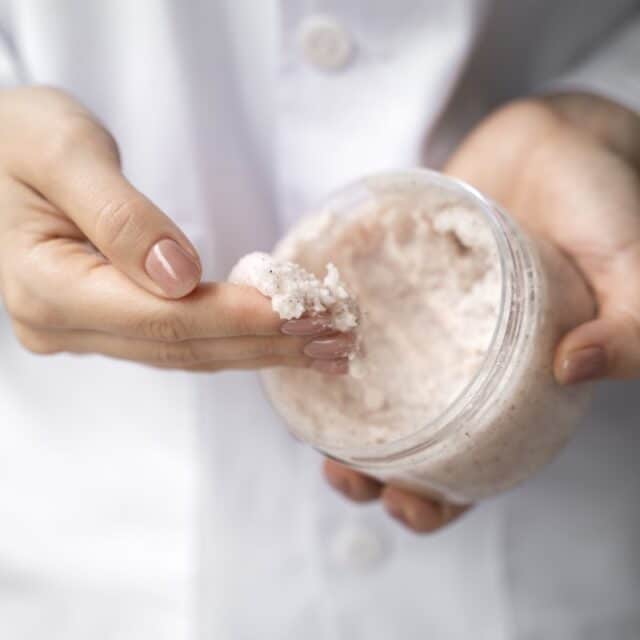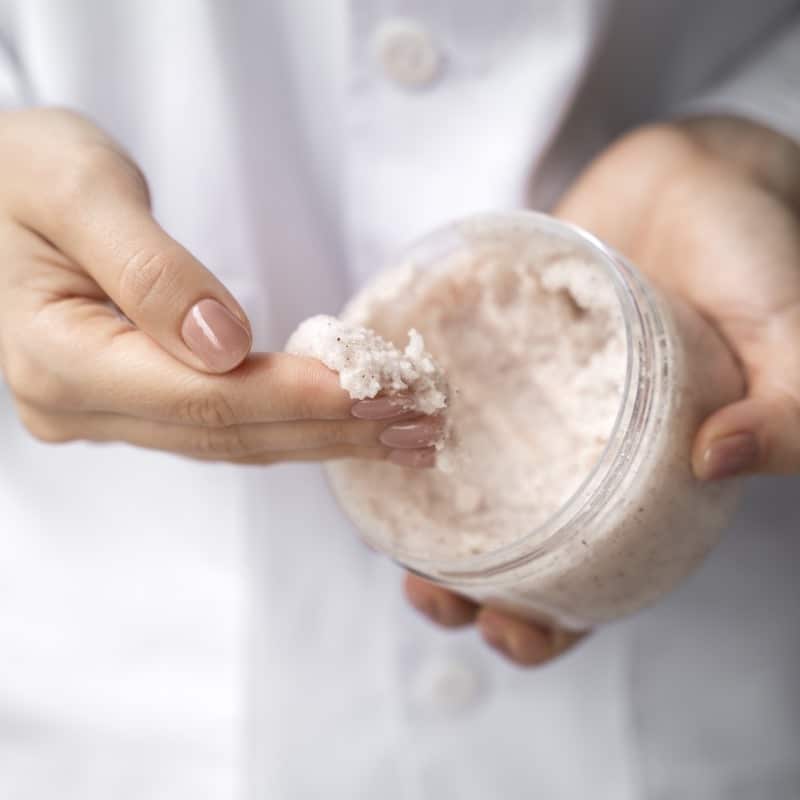
One of the most common skincare procedures is exfoliation, which results in a smoother texture, unclogged pores, and a more refreshed look. Exfoliators come in a variety of forms, ranging from gritty scrubs to creams based on enzymes and acid treatments, but not all of them meet the same safety standards. The Cosmetic Product Safety Report (CPSR), a required document that certifies a product is safe for consumer use, must be used to evaluate each type in the EU. For brands, this entails closely monitoring the substance used in physical scrubs, the pH and concentration of acids in chemical peels, and the stability and activity of enzymes. In this blog, we will explore how brands can prepare a CPSR for body scrubs and exfoliators, covering abrasive particles, acid regulations, enzyme data, and the broader EU compliance framework.
Why Exfoliation Safety Matters for EU Compliance
Because of the way they work with the skin, exfoliators fall into a unique category in skincare. While acids or enzymes dissolve the bonds between dead skin cells, scrubs produce controlled abrasion. If the formula is not properly balanced, both methods temporarily remove the skin’s natural barrier, increasing the likelihood of irritation and sensitivity. For this reason, exfoliators are regarded in safety evaluations as cosmetics with a higher risk.
The foundation of EU compliance is the cosmetic product safety report, which assesses all safety factors prior to a product’s release onto the market. Because the risks are different for body scrubs and glycolic acid peels, a CPSR for each will look very different. However, before the Responsible Person can submit the product notification in the CPNP database, both must include information about the product’s testing, exposure levels, toxicological profiles, and ingredients.
Regulatory Landscape at a Glance
According to the EU Cosmetics Regulation (EC No 1223/2009), a cosmetic product safety report must accompany each cosmetic that is sold in the EU. This report must be prepared by the safety assessor prior to the product being put on the market. Additional guidance documents, such as the SCCS Notes of Guidance, which describe how to assess exposure, toxicological data, and product performance, support the process for exfoliators.
Official stances on acids are well-documented. In the past, the SCCNFP (now the SCCS) assessed alpha-hydroxy acids like lactic and glycolic acid and suggested cautious limits to lower the risks of irritation and UV sensitivity. The FDA and U.S. CIR also influenced industry practice, which adopted somewhat broader contours: ≤30% AHA for professional salon use and ≤10% AHA at pH ≥3.5 for consumer products. These figures are frequently used as standards for safe formulation. There are no stringent EU concentration limits for enzymatic peels; instead, safety assessors must rely on stability tests and supplier activity data. The EU microplastics restriction (2023/2055), which forbids the use of non-biodegradable microbeads in rinse-off products, is the main rule governing physical scrubs.
CPSR Part A: Safety Information for Exfoliators
Full Formula and pH Profiling
The complete formula in both qualitative and quantitative terms is required by Part A of the CPSR. This entails identifying the precise abrasive particles used, their source, and their concentration in scrubs. The assessor needs to see the final formulation’s pH, free acid content, and acid percentage for chemical peels because pH affects how harsh the acid will be on skin. Supplier information on enzyme identity, activity units, and assay procedures must be provided for enzymatic peels. The assessor is unable to determine exposure or margin of safety without this transparency.
Stability and Physicochemical Data
For the duration of their shelf life, exfoliators must be kept safe. Stability testing makes sure that enzymes don’t denature or lose their activity, pH levels don’t drift to dangerous ranges, and scrubs don’t separate or solidify. Drift toward a lower pH can greatly raise the risk of irritation for AHAs. Accelerated and real-time stability studies are crucial for enzymes like papain and bromelain because their activity must be maintained under typical storage conditions.
Microbiological Quality and Packaging
Like all cosmetics, exfoliators must meet microbiological quality requirements. Challenge tests verify the strength of the preservative system, which is particularly important in water-rich formulations such as scrubs and enzyme gels. Packaging interactions must also be evaluated. Acids can corrode inappropriate containers, and enzymes may be deactivated by exposure to oxygen or light. The CPSR must therefore confirm that packaging protects both consumer safety and product efficacy.
Safety Specifics by Exfoliation Type
Physical Scrubs: Particle Safety and Microplastics Rules
A careful examination of the abrasives used is necessary for the CPSR for body scrubs. Critical factors include particle size, shape, and concentration: larger or jagged granules can result in microtears in the skin, whereas smoother, biodegradable particles are safer and kinder. Adherence to the EU’s microbead ban is equally crucial. Since plastic microbeads in rinse-off exfoliants are forbidden by Regulation (EU) 2023/2055, the only biodegradable substitutes that are permitted are sugar, salt, ground seeds, or natural minerals. Evidence of particle identity, granulometry, and consumer tolerance studies will be anticipated by safety assessors.
Beyond compliance with the microbead ban, particle safety also extends to their long-term impact on the skin barrier. Within the CPSR process, assessors will look for evidence that repeated use of abrasives does not lead to irritation, increased transepidermal water loss, or inflammatory responses. For this reason, both in vitro and consumer tolerance studies are valuable to demonstrate skin compatibility. In addition, manufacturers are expected to provide documentation proving the biodegradability of the particles, their toxicological profile, and traceability to sustainable sources. Such evidence not only supports regulatory compliance but also strengthens consumer trust and market positioning.
Chemical (AHA/BHA) Peels: Concentration and pH Matter
Acids like salicylic, lactic, and glycolic acids are essential to chemical exfoliators. The safety of these products depends on both pH and concentration. Although a framework is provided by the established guidelines of ≤10% AHA at pH ≥3.5 for consumers and ≤30% for professional salon use, each CPSR is still required to determine the margin of safety for the particular formulation. Stability data demonstrating that pH stays within range over the course of shelf life should also be included in the report. Additionally, labels must include unambiguous sun safety warnings because AHAs can increase UV sensitivity. Neglecting pH data or omitting UV warnings are among the most common reasons for compliance issues in this category.
Enzymatic Peels: Activity Retention and Skin Compatibility
Papain, bromelain, or ficin are typically used in the formulation of enzymatic peels. Even though they are frequently promoted as being kinder than acids, safety inspectors still need to see proof of consistency and stability. Supplier assays of enzyme activity, expressed in units, and stability data showing that activity is sustained at the recommended pH and storage conditions should be included in the safety report for cosmetic products. Unstable enzymes may cause unanticipated irritation, while enzymes that lose their activity may render the product ineffective. Additionally, for repeated consumer use, the CPSR must verify that the proteolytic activity is within safe bounds.
CPSR Part B: Safety Assessment and Labeling
Exposure and Margin of Safety
Part B assesses the product’s safety as used by customers. This entails estimating the amount of product applied per use and the area covered by scrubs. Because leave-on treatments are riskier than rinse-off scrubs, exposure for peels must take frequency and contact time into account. By contrasting estimated exposure with toxicological thresholds like the NOAEL (No Observed Adverse Effect Level), the assessor determines the margin of safety (MoS).
Irritation and Phototoxicity Concerns
Particularly with chemical peels, there is a chance of irritation and UV sensitivity. Because AHAs can increase phototoxicity, the SCCNFP has emphasized how important it is for labels to advise consumers about sun protection. Enzymatic peels can result in unexpected sensitivity if the enzyme activity is too high, while even rinse-off scrubs can irritate skin if the particles are too harsh. Therefore, a section on irritation potential, phototoxicity risks, and labeling strategies for mitigation must be included in the CPSR.
Label Claims and Responsible Person Duties
Clear ingredient lists, allergen declarations, and warnings must all be included on labels that correspond with the safety assessment. Products containing AHAs, for instance, ought to advise users to wear sunscreen and limit their exposure to the sun. Products intended for professional use must be accompanied by explicit instructions that restrict their use to qualified individuals. The CPSR, the Product Information File, and the labels must all match and be kept up to date by the Responsible Person, who is legally responsible under EU law.
Practical CPSR Checklist for Exfoliators
- Gather the full formula with INCI names, concentrations, and relevant details (acid free %, final pH, enzyme units, particle size).
- Conduct stability tests, including pH monitoring for acids and activity retention for enzymes.
- Perform microbiological challenge testing and packaging compatibility studies.
- Complete exposure assessments and calculate margins of safety.
- Draft labeling with allergens, sun-safety messages, and professional-use warnings where needed.
- Finalize the Product Information File (PIF), appoint a Responsible Person, and submit notification to the CPNP before launch.
Common Pitfalls to Avoid
Ignoring the EU microplastics restriction, which prohibits plastic microbeads in rinse-off scrubs, is one of the most common mistakes. Relying only on nominal AHA percentages without recording the final pH, which establishes acid strength, is another frequent error. Additionally, brands frequently downplay the significance of enzyme stability data, which results in inconsistent product performance. The significance of a well-prepared CPSR is highlighted by the fact that each of these mistakes may result in delays in market approval or outright non-compliance.
Frequently Asked Questions about CPSR for Exfoliators
Q1. Is there a hard limit on consumer goods that have AHAs?
Indeed. While professional peels may reach 30% under trained supervision, the commonly accepted recommendation for consumer products is ≤10% AHA at pH ≥3.5.
Q2. Compared to acids, are enzymatic peels safer?
Not always. Even though enzymatic products might feel softer, stability data, irritation studies, and activity profiling are still necessary to verify their safety.
Q3. Are plastic microbeads still suitable for use in body scrubs?
No. Rinse-off scrubs that contain plastic microbeads are prohibited by EU Regulation 2023/2055. The CPSR for body scrubs must specify the use of biodegradable substitutes.
Q4. Does every product variant require its own CPSR?
Indeed. You must create a different CPSR for every formula if you alter the pH, acid levels, enzyme concentration, or scrub particles.
Conclusion: Safe and Compliant Exfoliators with CPSR
Although exfoliating products clearly benefit consumers, there are special safety risks associated with them as well. Every mechanism, whether using enzymes, acids, or abrasives, necessitates a different method for evaluating safety. Brands can demonstrate compliance with EU law, steer clear of regulatory pitfalls, and reassure consumers by creating a comprehensive safety report for cosmetic products. This entails recording particle identity and adhering to the microbeads ban for scrubs, demonstrating adherence to pH and concentration limits for acids, and obtaining stability data that validates consistent activity for enzymes. For body scrubs and exfoliators, a properly prepared CPSR guarantees that each product produces results responsibly and safely.
Visit our CPSR service page and read our most recent blogs on cosmetics compliance to find out more about how Certified Cosmetics can help you with your CPSR preparation and to examine detailed compliance advice.

